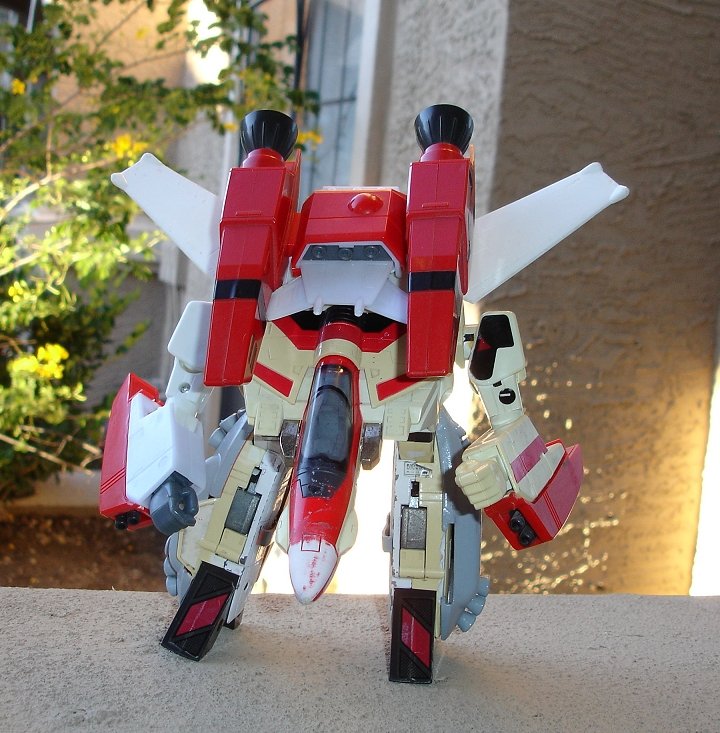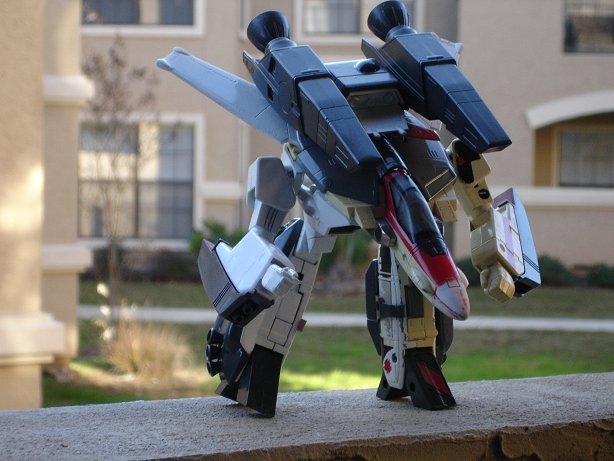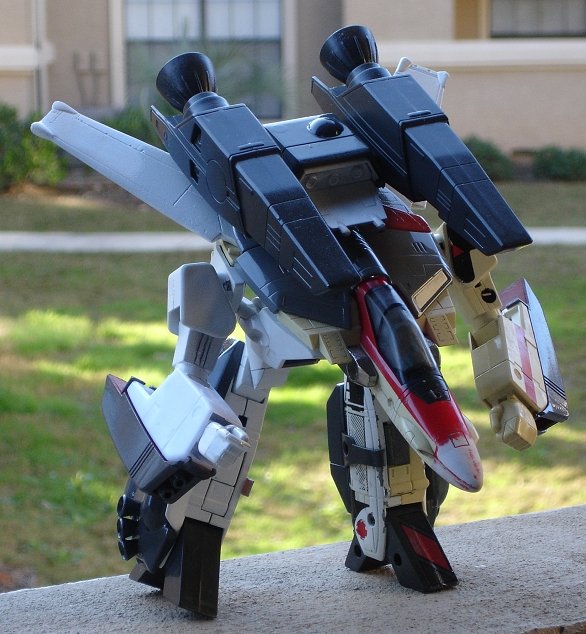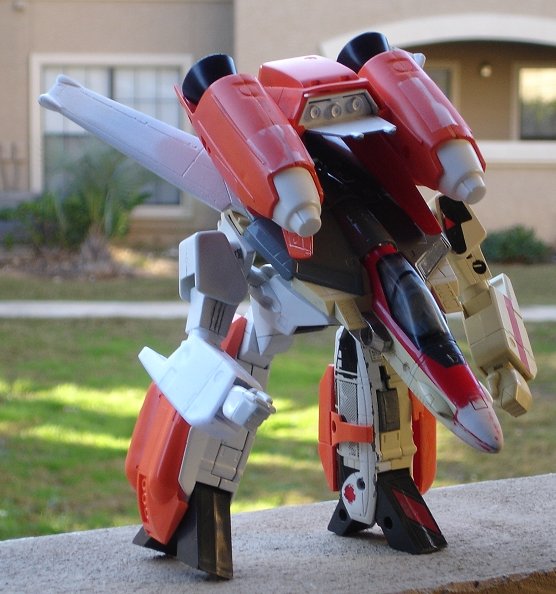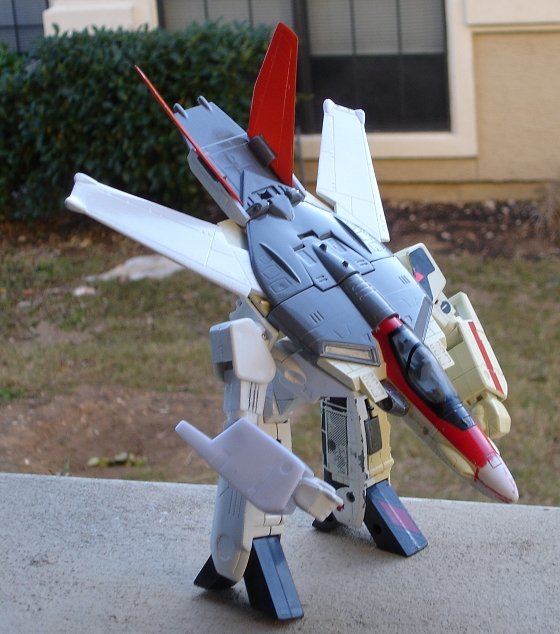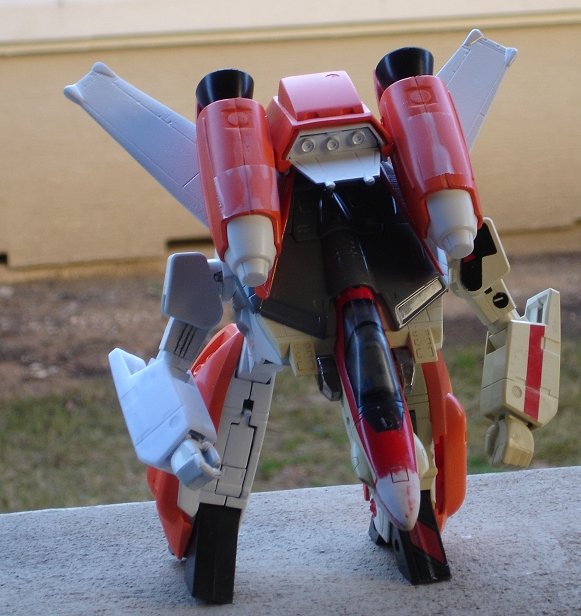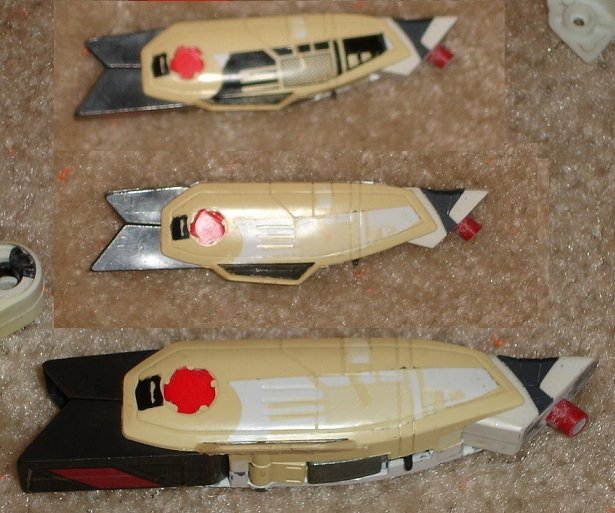-
Posts
1342 -
Joined
-
Last visited
Content Type
Profiles
Forums
Events
Gallery
Everything posted by Skull-1
-
This assumes you are running at high power settings at all times, neh? If so, this is countered by the animation when the VF-1D crashes into the Zentraedi. The exhaust goes from low to high and the heat signature increases dramatically along with thrust output. The reactor has to be "throttleable" (for lack of a better term) or it is unworkable. Besides, it is a FUSION reactor and my understanding is that FUSION reactions are much harder to sustain than FISSION ones, relatively speaking (and from a faded memory). There is definitely a diffusive effect for reasons mentioned, but you're not going to be putting out 23K kg of thrust (how heavy is this Valk any way???) all the time during VTOL ops.
-
http://robotech-aod.com/images/ValkToys/VT-1-Trainer/
-
Jetfire... About to be disected... [attachmentid=39462] And a little spin on the FAAST Pack theory... [attachmentid=39463] [attachmentid=39464] Perhaps Orange is a better color? [attachmentid=39465] [attachmentid=39467] Sneak preview of the color scheme... [attachmentid=39466]
-
-
I can't get them up... Even my FTP server is out of whack. UGH.
-
*sigh* I can't get it to upload. Why does this happen? When I try to add a photo attachment I get: "The page cannot be displayed "The page you are looking for is currently unavailable. The Web site might be experiencing technical difficulties, or you may need to adjust your browser settings."
-
This turkey is JUST getting started. I thought about using standard FAAST Pack boosters with the VT-1 legs because it looks mean. Not sure if I will or not. HOWEVER..... Please note the effects of yellowing UNDERNEATH the stickers. The areas not exposed to light remained white.
-
The correct designation would be: YVF-1 and XVF-1 at any rate.
-
No misunderstanding at all. I am fully aware of the CW that implies a Valk's engine uses nothing but air for RM in the atmosphere. I cut my teeth on this discussion ten years ago with nuclear physicists and the like. Trust me I am fully aware of what is being discussed--they had my head spinning with equations. And I respectfully disagree. There are numerous reasons to use a bypass fan, one of which is heat signature. There is no need to light yourself up to the entire world through your thermal signature. No I don't agree. Heating everything in one spot to a higher temperature is harder than having two "heat transfer manifolds" of a greater surface area to do the job as needed (IMHO). Perhaps we should define "efficient".
-
Consider the term REACTION *MASS*. The heavier the mass expelled the more thrust per unit of volume. Just like flash retardent JP-5 (?) (Navy / Marine Corps) had more thrust per gallon than standard JP-4 (Air Force) so too will a combustible or water-based RM have more thrust than the air itself as the latter is not as heavy. Not all of a jet's thrust is expanded air. The weight of the fuel burned does affect thrust output. At least it did when I last actually paid attention to this stuff 15 years ago... How are you going to duct this heat? Are you implying these Valkyrie engines do not have any bypass air at all? That is a dubious prospect at best, IMHO. The "Afterheater" concept is more efficient because it is only used when needed. The additional "heater core" is simply that much more area to allow for thermal transfer to the RM. By definition it will be more efficient. Also, heating a larger volume by a lesser amount is much easier than heating a smaller volume by a higher amount. Heaging 100 cubic feet by 20 degrees C is certainly easier than heating 50 cubic feet by 50 degrees C... (Insert your own numbers).
-
Here is a summation that a buddy of mine provided. I think it is pretty succinct regarding why we see "AFTERBURNER" at any rate. "Afterburners work by adding energy to a supersonic flow. The equations are ugly, but basically in de Leval nozzle supersonic flow, it's possible to dump more energy in and have it go very efficiently into flow velocity (rather than mostly into heat). That's what an afterburner is. Dump fuel into the superheated exhaust, it combusts with the remaining oxygen, but most of the energy goes straight into flow velocity and not heat. "In a reactor engine, they're probably dumping more fusion plasma into the exhaust flow. Same principle, except no combustion, so the term "afterburner" is simply a legacy term no longer strictly accurate, but close enough to be retained. "The exhaust would be blue because that would be its blackbody temperature: in the 8000-10000 Kelvins (or degrees Celcius, if you prefer - the difference is small) range."
-
Max's dogfight wit Milia is a prime example of instantaneous thrust responses. The Battroid flits about the sky like it is being held with guide strings. *NO* conventional engine can react that way. Are we going to base this on the engine running at full power almost the entire time with thrust being vented in all different directions to control output? I don't buy that explanation. Also, blue flamed exhaust implies a very efficient *COMBUSTION*, not just some gee whiz thermonuclear reactor heating air.
-
My airplane has FADECs and one of the fastest spoolup times in the industry. It is NOT instantaneous as we see in Macross. It can't be. Physics. Even if you had an instantaneous spoolup you will still not see the acceleration rates we see in the animation. There is something else at play.
-
Good point.
-
I am confining my PRIMARY argument to atmospheric operation, yes. In space you have no other choice but a rocket effect, i.e. a reactor heats RM (water, heavy water, plasma, whatever you choose).
-
Yet the ambient temperature in space is magnitudes lower than it is in the atmosphere, thus negating some of that problem.
-
Well no offense intended as you are obviously very sharp...BUT... Jet engines, regardless their type--turbofan or turbojet, Kerosene or Themonuclear--have a definite lag between the time when power is applied and when it is felt. The larger the bypass ratio the smaller the lag time is at low altitudes as a large N1 fan is in effect a propellor of sorts. The lag is still quite large. The Valkyrie appears not to have such a lag. The only way this can be overcome is with a rocket-type effect IMHO. You can't just add extra heat. The N2 fan will melt. I totally understand the cooling effect that air has on an engine. HOWEVER, you cannot go from nominal to maximum rated power in a matter of moments without overtemping the engine. There's simply not enough airflow fast enough to get you there. Try it with your car on a hot day sitting still. Rev the engine rapidly and momentarily. The temperature *WILL* spike. The airflow over the radiator is not going to instantaneously cool enough to prevent it. That's a combustion engine. Imagine a "star heat reactor". OUCH. Your only hope is to "AFTERHEAT" or "HEAT" the bypass air in conjunction with some sort of explosive, expansive, rocket-effect RM in the tail feathers to boost you forward. That is probably what "OVERBOOST" actually means. Also, the more area you have exposed to the air flowing over the reactor the more efficient the heat transfer. Thus an additional heater downstream is more efficient than a single *HOTTER* reactor would be.
-
Nonsense hardly. You are not going to get an instantaneous reaction the way we see it in the show without propellant of some sort. It's akin to "slippage" with a boat screw. The compressor simply cannot shove that much air through the engine that quickly and the engine cannot draw it on its own. Something else is at work here and I think it has to be chemical on some level. Why heat it to a higher temperature and melt the engine in transition when you can just heat the bypass air using the same temperature ratio as in the primary stage? You will avoid thermal shock to the reactor and increase engine life dramatically. There's certainly no other reason to have a "third stage reactor mixer" in the feet. You try flitting about the sky with those instantaneous bursts of power we see and watch what happens to your reactor temps. Might as well use what's left to make pots and pans 'cause it isn't going to last more than a couple of seconds.
-
It is a thermonuclear turbofan if you ask me. 1) The heat from the reactor heats air at the N2 fan which is geared to the N1 fan spool. 2) This air (because it has been heated) flows across the N2 fan, spinning it. 3) The N2 fan spins the N1 fan (front of engine). 4) Propulsion is provided by air being pulled in by the N1 fan (some of which goes into the core and is heated, the rest of which is ducted AROUND the heated section--bypass air). The heated air is exhausted at high velocity as thrust. The bypass air is exhausted at a slightly lower velocity as thrust. At low altitudes the N1 Fan does most of the propulsion. At high altitudes the heated air does most of the work. An AFTERHEATER would work by heating the bypass air and increasing its velocity, as well as adding additional heat to the already heated core air. AFTERHEATER. If you use a combustible RM to do this then it is an AFTERBURNER.
-
If you are using a combustible of some sort (like a rocket does) then you indeed burn something. And again, if "AFTERBURNER" is not the proper term for it, then "AFTERHEATER" is. The principle is the same.
-
Not by much. On the Embraer Legacy for example, we have three takeoff thrust modes that equate to 90%, 100%, and 110% of normal thrust. We use the minimum necessary for our takeoff weight (if we can't get off the ground at 90% we go to 100%, if 100% won't work we go to 110%). Any engine failure is handled through the FADEC by an Automatic Takeoff Thrust Control System (ATTCS) and that bumps you to the next thrust setting on the operating engine. Condition: Mode = Thrust Both Engines Operating: ALT-T/O = 90% - Engine Failure: ALT T/O-1 = 100% Both Engines Operating: T/O = 100% - Engine Failure: T/O-1 = 110% Both Engines Operating: E T/O = 110% - Engine Failure: E T/O RSV = 117% (8,810 lbs. st.) Which won't work too well on a Mach 3+ Valkyrie I'm betting.
-
You aren't running RM literally "through" the engine though in the sense of it mixing together. The plasma of the turbine is kept apart from the RM itself. Othewise I think you'd radiate the atmosphere and that would be unacceptable. The transference of heat from the reactor to the RM (air / water whichever) is what produces your thrust. You have two options... 1) Heat a smaller volume of air to a higher total temp to increase the velocity of the exhuast gas to a very high level. 2) Heat a larger volume of air to a lower (but hotter) total temp and increase the velocity of the exhasut gas to a (relatively) moderate speed. If you choose to do the former you are going to accelerate very slowly. The Valkyrie flits about the sky like a mosquito. I don't see how it does so without some chemical / combustible / RM Afterburner to heat the bypass air as well as to provide a "rocket" effect.
-
I thought it had a "Burner" setting. Good job.
-
They both suck but the mecha designs in MII are better than M7's.
-
I doubt magnets would make a roaring sound. We certainly hear thrust noise akin to *combustion* when (among other instances) Hikaru tries to stop his VF-1D from plowing into a Zentraedi Soldier around Episode Three. Afterheater would be my term for it..... But no pilot is going to call it an Afterheater. He'll just call it a burner and be done with it.


